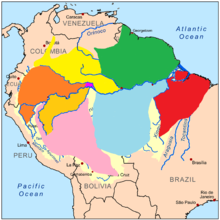Humboldt's squirrel monkey (Saimiri cassiquiarensis) is a species of squirrel monkey from Brazil, Colombia, Ecuador, Peru and Venezuela.[2][3] It had previously been considered a subspecies of the common squirrel monkey, S. scuireus, but was elevated to full species status based on a genetic study by Carretero-Pinzón in 2009.[2][3][4] A genetic study by Jessica Lynch Alfaro, et al indicated that the Ecuadorian squirrel monkey may be synonymous with Saimiri cassiquiarensis.[5] As of 2018, the Ecuadorian squirrel monkey is generally regarded as a subspecies of Humboldt's squirrel monkey, S. cassiquiarensis macrodon.[6][7]
| Humboldt's squirrel monkey | |
|---|---|

| |
| Scientific classification | |
| Domain: | Eukaryota |
| Kingdom: | Animalia |
| Phylum: | Chordata |
| Class: | Mammalia |
| Order: | Primates |
| Suborder: | Haplorhini |
| Infraorder: | Simiiformes |
| Family: | Cebidae |
| Genus: | Saimiri |
| Species: | S. cassiquiarensis
|
| Binomial name | |
| Saimiri cassiquiarensis (Lesson, 1840)
| |

| |
| Ecuadorian squirrel monkey range in orange; remainder of Humboldt's squirrel monkey range in yellow | |
Humboldt's squirrel monkey have a head and body length of between 25 and 37 cm (9.8 and 14.6 in) with a tail between 36 and 45 cm (14 and 18 in).[2] Its coloration is similar to that of the Guianan squirrel monkey but the fur on the base of the crown is golden yellow as compared with gray for the Guianan squirrel monkey.[2] It eats fruits when available, primarily between January and June, and also eats insects.[2]
References edit
- ^ Paim, F.P.; De La Torre, A.; Carretero, X.; Guzmán-Caro, D.C.; Stevenson, P.R.; Lynch Alfaro, J.W.; Boubli, J.P.; Urbani, B.; Palacios, E.; Silva Júnior, J.S.; Heymann, E.W.; Link, A.; Moscoso, P.; Ravetta, A.L.; Calouro, A.M. (2021). "Saimiri cassiquiarensis". IUCN Red List of Threatened Species. 2021: e.T160940148A192585552. doi:10.2305/IUCN.UK.2021-1.RLTS.T160940148A192585552.en. Retrieved 26 July 2022.
- ^ a b c d e Mittermeier, Russell A.; Rylands, Anthony B. (2013). Mittermeier, Russell A.; Rylands, Anthony B.; Wilson, Don E. (eds.). Handbook of the Mammals of the World: Volume 3, Primates. Lynx. pp. 392–393. ISBN 978-8496553897.
- ^ a b Phillips, Carson R. (2016). Rowe, Noel; Myers, Marc (eds.). All the World's Primates. Pogonias Press. pp. 306–307. ISBN 9781940496061.
- ^ Carretero-Pinzón, X.; Ruiz-García, M.; Defler, T. (2009). "The Taxonomy and Conservation Status of Saimiri sciureus albigena: A Squirrel Monkey Endemic to Colombia". Primate Conservation. 24: 59–64. doi:10.1896/052.024.0102. S2CID 85881653. Retrieved 2019-01-13.
- ^ Lynch Alfaro, J.W.; et al. (2015). "Biogeography of squirrel monkeys (genus Saimiri): South-central Amazon origin and rapid pan-Amazonian diversification of a lowland primate". Molecular Phylogenetics and Evolution. 82: 436–454. doi:10.1016/j.ympev.2014.09.004. PMID 25305518.
- ^ "Primates of the Neotropics". IUCN Primate Specialist Group. September 2018. Retrieved 2019-02-04.
- ^ "Saimiri cassiquiarensis macrodon". Mammal Diversity Database. Archived from the original on 2019-02-07. Retrieved 2019-02-04.
